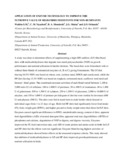Application Of Enzyme Technology To Improve The Nutritive Value Of High-fibre Feedstuffs For Non-ruminants

View/
Date
2011Author
Waititu, S.M.
Nyachoti, C. M.
Slominski, B. A.
Maina, J.G.
Ochanda, J.O.
Language
enMetadata
Show full item recordAbstract
A study was done to determine effects of supplementing a high (HF) and low (LF) fibre basal
diets with multicarbohydrases that degrade non-starch polysaccharides (NSP) on growth
performance and nutrient utilization in broiler chickens. The basal diets were formulated with or
without three blends of commercial enzymes (A, B or C) giving 8 treatments. The LF diet
(having 10.5% NSP) was based on wheat, corn, soybean meal, DDGS and canola meal, while the
HF diet (having 13.3% NSP) was based on sorghum, cottonseed meal, sunflower seed meal and
brewers’ dried grains. The constituent enzymes activities of each blend varied between 1,100 to
5,000 units (U) of cellulase, 100 to 1,000 U of pectinase, 50 to 400 U of mannanase, 40 to 1,400
U of galactanase, 850 to 1,500 U of xylanase, 250 to 1,500 U of glucanase, 2,000 to 10,000 U of
amylase, and 150 to 1,000 U of protease per kilogram of diet but were similar for invertase (600
U) and phytase (500 U). The diets were fed in mash form to male broiler chicks housed in
individual cages from 1 to 21 days of age. Birds fed HF diets had significantly lower feed intake
(FI), body weight gain (BWG), and higher gizzard-to-body-weight ratios than those fed LF diets.
Enzymes caused significant differences in BWG, metabolizable energy content of diets, apparent
ileal digestibilities (AID) of neutral detergent fibre, apparent total tract digestibilities (ATTD) of
phosphorus and calcium, degradation of NSP in digesta, and digesta viscosity. Enzymes
improved the FI, feed conversion ratio, and AID of crude protein and amino acids in birds fed LF
and HF diets but the effects were not significant. Enzyme blend having highest activities of
multicarbohydrases showed better effects on the measured response criteria. This study showed
that addition of multicarbohydrases to LF and HF diets improved growth performance and
nutrient utilization in birds.
